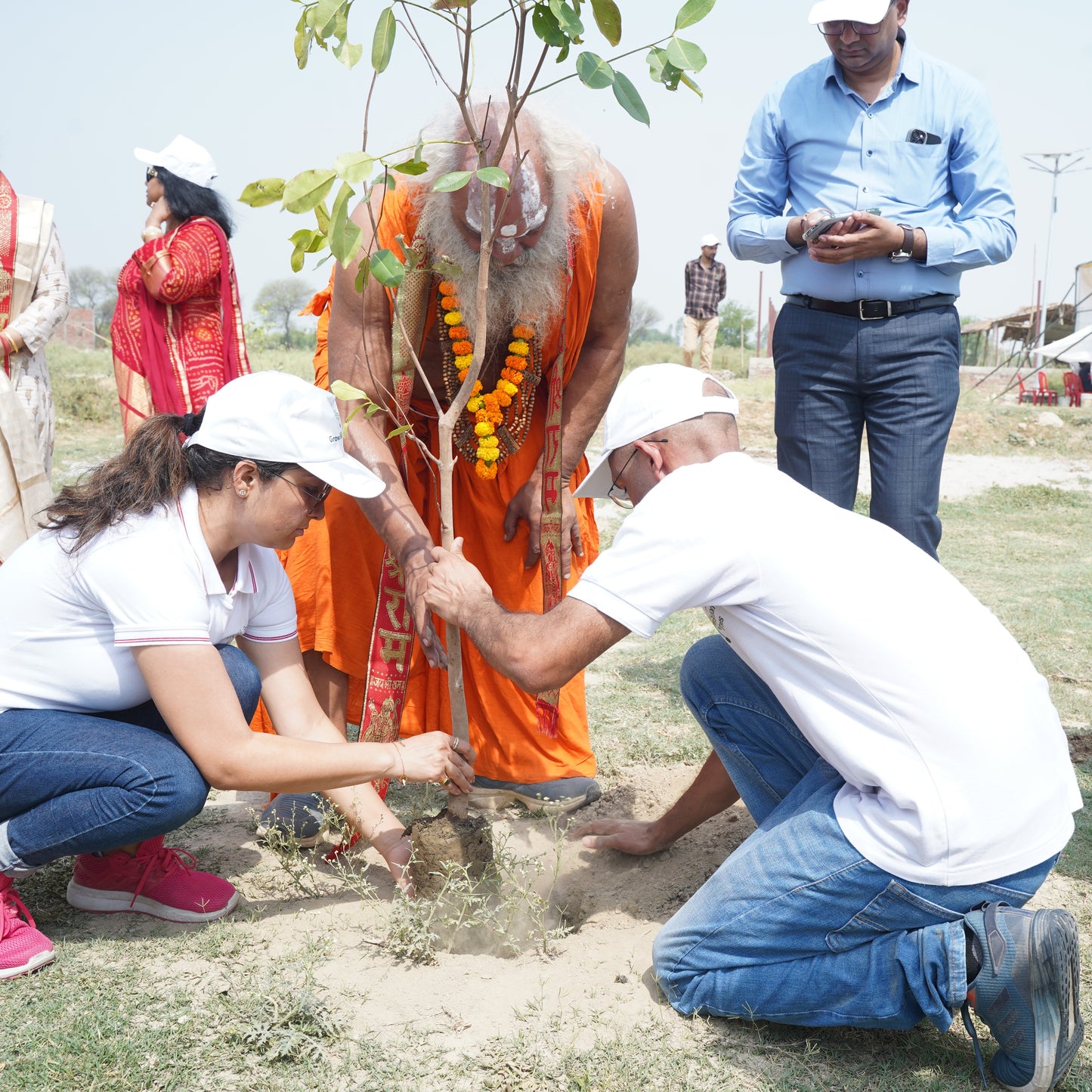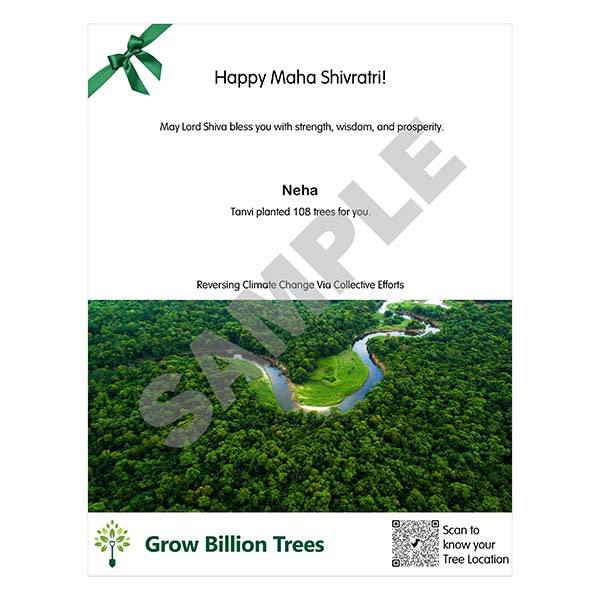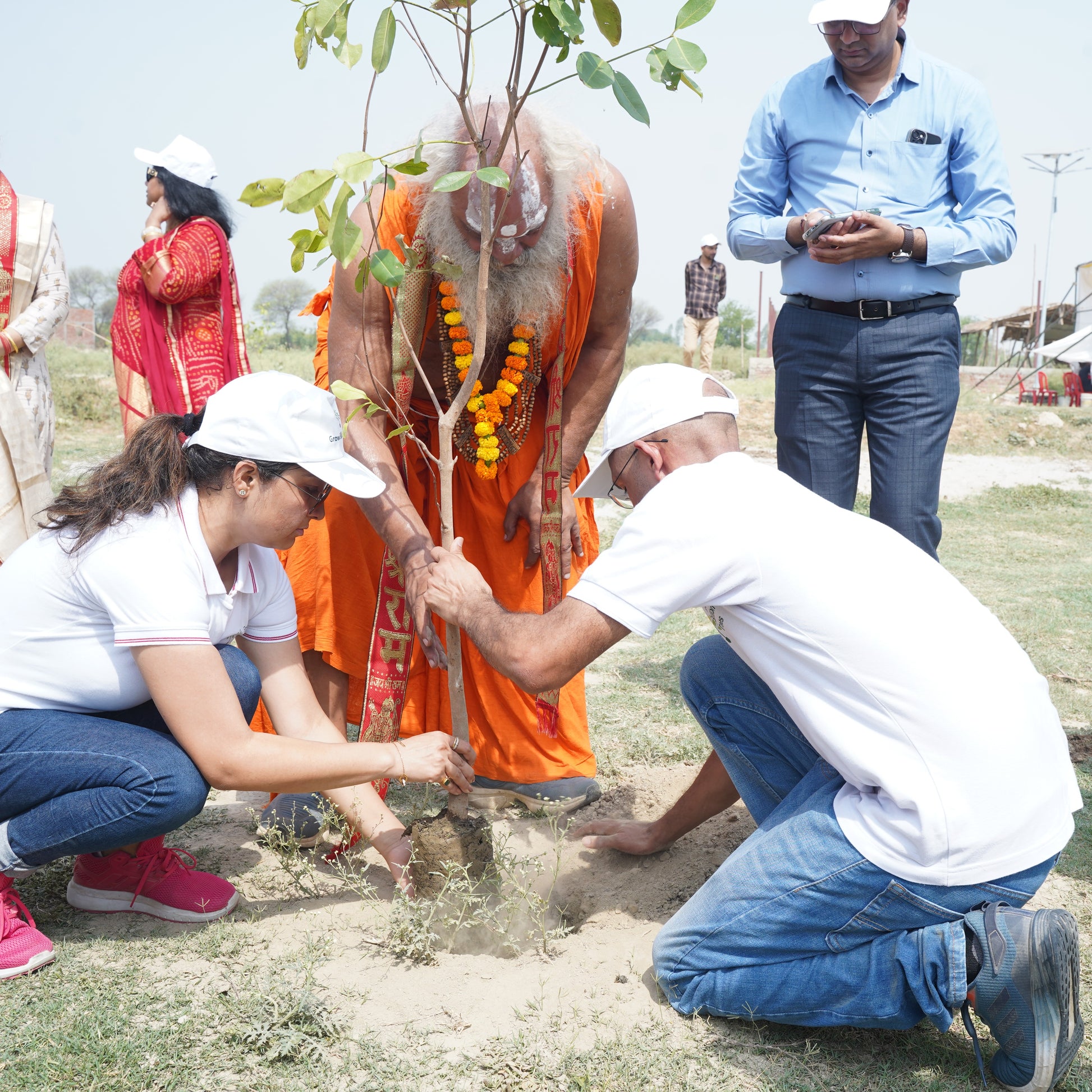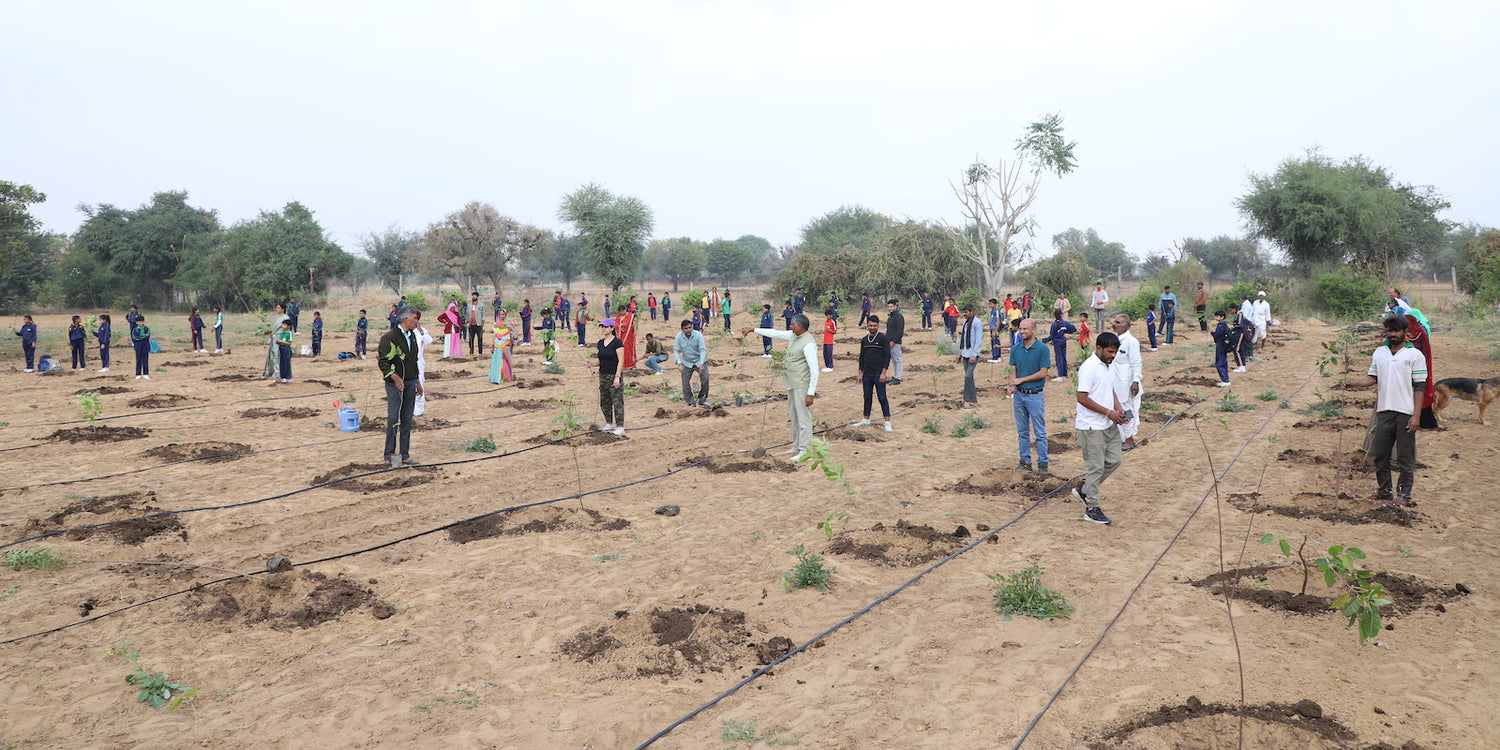Trees for Maha Shivratri
Trees for Maha Shivratri
🌳 2-3ft Tree + 3 Years Nurturing + Geo-Tagged
💡 Tip: 3 Trees for Trinetra dhari
12 Trees for 12 Jyotirlingas
108 Trees for 108 names of Shiva
Couldn't load pickup availability
What you get ?
Tree(s) Plantation
Tree(s) Plantation
A tree(s) native to the region will be planted within 7 -10 days, and post-plantation monitoring will be thoroughly managed.
*You will receive an email/whatsapp notification immediately after the tree(s) plantation. or you can check the current status by logging into "My Account" anytime.
e-Greeting Card of Tree(s) Plantation for Gifting
e-Greeting Card of Tree(s) Plantation for Gifting
If you want to gift these tree(s) to your loved ones, You can generate an e-Greeting card for tree(s) plantation by logging into "My Account" after placing order.
*Please generate it within 5 days of placing the order.
e-Certificate of Tree(s) Plantation
e-Certificate of Tree(s) Plantation
A e-certificate of Tree(s) Plantation with the project details will be issued in your name after tree(s) plantation.
*You can download it from "My Account".
Geotag of your Tree(s)
Geotag of your Tree(s)
You can immediately track the live location of the project chosen for your tree(s) plantation, by logging into "My Account" or, by scanning the QR code on the certificate.
*You can see Your Name in respective Project/Forest.
If you want to gift these tree(s) to your loved ones, You can generate an e-Greeting card for tree(s) plantation by logging into "My Account" after placing order.
View full details


Planting trees on Shivratri is a way to honor Lord Shiva, who is often associated with nature and the environment. Lord Shiva is often de Read more
Trending
Plant Trees for Maha Shivratri - Eco-Friendly Offering
Description:
Planting trees on Shivratri is a way to honor Lord Shiva, who is often associated with nature and the environment. Lord Shiva is often depicted with a snake around his neck, which symbolizes his connection to nature and the environment. By planting trees, we can pay homage to Lord Shiva and show our reverence for the environment and the natural world.
Scope:
- Enhancement of Biodiversity
- Increase in Green Cover
- Reduction of Man-Animal Conflict
- Generation of Rural Employment
- Improvement of Wildlife Habitats
Tree Species:
The species of trees that are planted depend on the project, and they are chosen based on their native habitat in the corresponding ecological zone.
Why trees?
Tree plantation on Shivratri is an important tradition in many parts of India. Here are four reasons why planting trees on Shivratri is significant:
-
Celebrating the connection between Lord Shiva and nature: Lord Shiva is often associated with nature and the environment. Planting trees on Shivratri is a way to celebrate this connection and pay homage to Lord Shiva.
-
Promoting environmental sustainability: Planting trees is a vital step towards promoting environmental sustainability. Trees absorb carbon dioxide from the atmosphere and produce oxygen, making the air cleaner and more breathable. Planting trees also helps to preserve biodiversity and promote sustainable development.
-
Contributing to the fight against climate change: Climate change is one of the biggest challenges facing the world today. Planting trees is a significant way to contribute to the fight against climate change, as they absorb carbon dioxide from the atmosphere, which is a major greenhouse gas.
-
Creating a sense of community and responsibility: Planting trees on Shivratri can bring people together and create a sense of community and responsibility. When people come together to plant trees, they are working towards a common goal of creating a greener and more sustainable future for themselves and future generations.
Overall, planting a tree together on Shivratri is a unique and meaningful way to show your love and devotion for Lord Shiva and Goddess Durga & make a positive impact on the environment.
Let us make a pledge to plant and care for trees not only on Shivratri but throughout the year to create a sustainable and greener future for ourselves and future generations.
Devrai ( Sacred Grooves):
Devrai, or sacred groves, have been an integral part of India's cultural and religious heritage for centuries. These groves are considered sacred and are preserved as natural sanctuaries for a variety of flora and fauna. On Shivratri, the significance of Devrai becomes even more prominent, as Lord Shiva, who is considered the lord of nature, is worshipped. Here are some reasons why Devrai or sacred groves are important on Shivratri:
-
Biodiversity conservation: Devrai is an important means of conserving biodiversity. These groves are often home to a variety of plant and animal species, many of which may not be found elsewhere. By preserving these groves, we can help to protect and promote the growth of a wide range of species, which is essential for maintaining ecological balance and preventing the extinction of certain species.
-
Religious significance: Devrai has immense religious significance on Shivratri. Lord Shiva is known as the lord of nature and is worshipped for his power to create, destroy and preserve. He is also considered the lord of forests and wild animals. Devrai is considered a manifestation of Lord Shiva's divine presence, and therefore, it is an important part of the celebrations during Shivratri.
-
Ecological balance: Devrai plays an important role in maintaining the ecological balance of the environment. These groves act as natural carbon sinks and help to regulate the climate by absorbing carbon dioxide from the atmosphere. They also help to prevent soil erosion and maintain water resources by preserving the groundwater table and regulating water flow.
-
Cultural heritage: Devrai is an important part of India's cultural heritage, and its preservation is necessary for maintaining the continuity of this tradition. The practice of protecting sacred groves has been passed down from generation to generation, and the preservation of these groves is essential for keeping this tradition alive.
In conclusion, Devrai, or sacred groves, have immense ecological, religious, and cultural significance on Shivratri. By preserving these groves, we can not only protect biodiversity and promote ecological balance but also pay homage to Lord Shiva and maintain our rich cultural heritage.
Navratri tree planting
Planting trees during Navratri is a great way to celebrate the festival while also promoting sustainability and environmental consciousness.
Eco
Emphasizing eco friendly practices during Navratri can include planting trees, reducing waste, and promoting sustainable practices.
Navratri green initiatives
Encouraging green initiatives during Navratri can include planting trees, using eco friendly products, and reducing carbon footprint.
Navratri tree plantation campaign
Creating a tree plantation campaign during Navratri can help promote environmental awareness and create a positive impact.
Tree planting for Navratri
Encouraging tree planting during Navratri can create a positive impact on the environment and promote ecofriendliness.
Navratri sustainability
Promoting sustainability during Navratri can include tree planting, reducing waste, and using eco-friendly products.
Green Navratri celebrations
Celebrating Navratri in an environmentally friendly manner can include tree planting and promoting sustainable practices.
Navratri eco initiatives
Encouraging eco initiatives during Navratri can include tree planting, reducing carbon footprint, and using renewable energy sources.
Navratri green movement
Joining the green movement during Navratri can include tree planting and promoting environmental consciousness.
Navratri tree donation
Donating trees during Navratri can create a positive impact on the environment and promote eco-friendliness.
Tree plantation drive for Navratri
Organizing a tree plantation drive during Navratri can create a positive impact on the environment and promote sustainability.
Navratri green revolution
Joining the green revolution during Navratri can include tree planting and promoting eco friendly practices.
Navratri green pledge
Taking a green pledge during Navratri can include tree planting and promoting sustainable practices.
Navratri eco celebrations
Celebrating Navratri in an environmentally friendly manner can include tree planting and reducing carbon footprint.
Navratri green awareness
Promoting green awareness during Navratri can include tree planting and educating others about sustainable practices.
Navratri tree plantation event
Hosting a tree plantation event during Navratri can create a positive impact on the environment and promote eco-friendliness.
Navratri environmental initiatives
Encouraging environmental initiatives during Navratri can include tree planting, reducing waste, and promoting sustainable practices.
Navratri green festival
Celebrating Navratri as a green festival can include tree planting and promoting eco-friendly practices.
Navratri tree sapling distribution
Distributing tree saplings during Navratri can promote environmental awareness and create a positive impact on the environment.
Navratri green community
Creating a green community during Navratri can include tree planting and promoting sustainable practices to create a positive impact on the environment.
Most Popular
Impact of your Tree
-
Releases Oxygen
A mature tree produces around 120 kilograms of oxygen per year, which is sufficient for one human per year.
-
Reduces Air Pollution
A tree absorbs harmful gases like CO2, NO2 released by factories and vehicles, which can have serious health problems for us
-
Removes CO2
A Tree removes 22 KGs of CO2 from atmosphere per year, which is equivalent to the CO2 realeased by a human in 10 days.
-
Cooling Effect
A Tree generates cooling effect of around 10 room size ACs by providing shade and through a process of transpiration.
Special Plantations
FAQ
Why plant trees on Mahashivratri?
Planting trees on Mahashivratri is considered a way of showing reverence to Lord Shiva, who is associated with nature and the environment.
What types of trees can be planted on Mahashivratri?
Any type of tree can be planted on Mahashivratri, but it is recommended to plant native trees that are well-suited to the local climate and ecosystem.
When is the best time to plant trees on Mahashivratri?
The best time to plant trees on Mahashivratri is in the morning, after taking a bath and performing puja (worship) rituals.
What are the benefits of planting trees on Mahashivratri?
Planting trees on Mahashivratri not only shows reverence to Lord Shiva but also helps to combat climate change, support local ecosystems, and improve air and water quality.
Why is giving trees as a gift a good idea?
Giving trees as a gift is a good idea because trees provide a long-lasting and meaningful present that symbolizes growth, life, and sustainability.
Can I personalize the tree?
Yes, you can personalize the gift of a tree via a certificate and a personalized greeting card with the gift.
Can I choose where the tree is planted?
No, tree plantation happens in bulk in forest with capacity of 10,000 or more plants. location is chosen based availability.
How can giving trees as gifts be environmentally friendly?
Giving trees as gifts can be environmentally friendly because trees provide numerous benefits, such as absorbing carbon dioxide, improving air and water quality, and providing habitats for wildlife.
How much does it cost to give a tree as a gift?
The cost of giving a tree as a gift start at Rs 99. It can vary depending on the tree species, size, and where it is located.
?




















